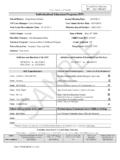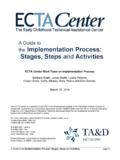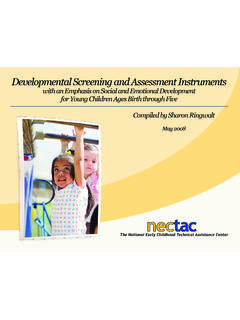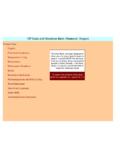Transcription of Examples of Functional Articulation IEP Goals - …
1 Examples of Functional Articulation IEP Goals The Early Childhood Technical Assistance Center updated May 2014 Improving Systems, Practices and Outcomes Background In 2012, NECTAC & ECO (now the ECTA Center) and WRRC staff published Developing High- Quality, Functional IFSP Outcomes and IEP Goals : A Training Package. Shortly after the introduction of the training package, a request was received to apply the criteria for high-quality, Functional IEP. Goals to Goals that would address a child's needs in the area of Articulation (making speech sounds).
2 Specific Examples were requested from speech-language pathologists to support writing Functional IEP Goals for children receiving services for Articulation only. Response Although the request asked for sample IEP Goals for children for whom social skills and behaviors to get needs met were age appropriate and not in need of therapy, we wish to suggest that problems with Articulation can in fact impact any or all three global child outcome areas. Preschoolers functioning at age level: use clear speech to effectively socialize (Outcome 1: Positive Social Relationships), participate in learning activities, (Outcome 2: Acquire and Use Knowledge and Skills) and.
3 Communicate their needs and wishes (Outcome 3: Using Appropriate Behavior to Meet Needs). It is critical to use appropriate Functional assessment techniques, such as observation and parent and teacher report, to view the child holistically and thereby render the full picture of exactly how a child's Articulation issues are impacting the child across settings and situations, both with peers and adults. Given that, we have developed sample IEP Goals that address each of the three global outcome areas and include some child context, such as potential Functional and academic areas that might be affected by difficulties with Articulation .
4 The criteria for a high-quality, participation-based IEP goal1 are: 1. The goal is written in plain language and is jargon-free. 2. The goal emphasizes the positive. 3. The goal describes the child's involvement in age-appropriate activities to address academic and Functional areas. 4. The goal is measurable and observable. 5. The goal describes how the child will demonstrate what they know or can do. 6. The goal describes the situations in which the child will demonstrate the goal, and does not name a placement or educational environment.
5 1. See more detail on the Criteria Defining High Quality, Participation-Based IEP Goals in Enhancing Recognition of High Quality, Functional IEP Goals at: ~pdfs/ Examples of Functional Articulation IEP Goals 1. Therefore, the sample IEP Goals provided in this document do not center around making sounds correctly or in a limited number of situations. Instead, the Goals reflect the child's successful participation in everyday routines and activities using skills that are typical of preschool children developing according to age expectations.
6 The main message to take away is that the Functional IEP. goal should reflect the child's needs for Functional participation in typical preschool routines and activities, and that the detail that would otherwise give the perception of non-functionality can still be captured and used to support speech and language therapy for Articulation . Specific information about the child's ability to make speech sounds as well as other abilities might be captured in the present levels of performance section of the IEP, or with the short term objectives connected with the child's annual Goals .
7 Several resources from the ECTA Center and ASHA were used to develop the sample IEP Goals provided below (see the list of resources at the end of this document). Please note that these goal statements are written to focus on functionality; they do not include measurability criteria. Use your state or local procedures for including measurability when putting this information into practice. Outcome 1: Positive social relationships Some children have difficulty speaking clearly with other children during center or other play activities.
8 If they are not easily understood, other children may not interact or answer, or may walk away from the child. Even if the child continues to try to communicate, and is having fun, the ability to communicate effectively and participate successfully in conversations has an impact on social situations. The child's communication with adults (family members and those within routines) may also be impacted. Sample IEP goal 1: Sample IEP goal 2: Robin will talk and be understood Sharon will communicate clearly, by other children during play taking turns in conversation during activities and social exchanges.
9 Play activities. Outcome 2: Acquire and use knowledge and skills In this area, speech language pathologists must consider the impact of Articulation problems on the child's ability to acquire and use the knowledge and skills that are typically mastered between the ages of 3-5. In other words, speech language pathologists should frame Articulation Goals in terms of the child's ability to learn. Pre- literacy, pre-math and pre-writing skills may all fall in this area depending upon the extent to which Articulation problems interfere with successful participation in learning activities, as well as whether or not the child communicates in such a way that the adults in the child's life ( teachers, child care providers, therapists) can accurately assess whether the child is learning and using age-expected preschool skills.
10 Examples of Functional Articulation IEP Goals 2. In the first sample IEP goal below, the child must use needed sounds and sound patterns in ways that help him successfully participate in verbal learning activities that may be rote or repetitive. The second sample addresses a child's ability to express herself clearly enough in spontaneous verbal learning activities, so that her teacher can tell whether or not she's grasping and using preschool concepts. Sample IEP goal 1: Sample IEP goal 2: Mateo will say words clearly during Shayla will say words and daily routines and activities that sentences clearly in response to require communication ( , story questions from adults during time, music).










